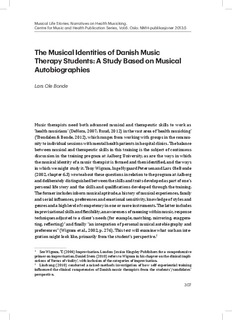| dc.description.abstract | Music therapists need both advanced musical and therapeutic skills to work as ‘health musicians’ in the vast area of ‘health musicking’ (Trondalen & Bonde, 2012), which ranges from working with groups in the community to individual sessions with mental health patients in hospital clinics. The balance between musical and therapeutic skills in this training is the subject of continuous discussion in the training program at Aalborg University, as are the ways in which the musical identity of a music therapist is formed and then identified, and the ways in which we might study it. Tony Wigram, Inge Nygaard Petersen and Lars Ole Bonde (2002, chapter 6.3) wrote about these questions in relation to the program at Aalborg and deliberately distinguished between the skills and traits developed as part of one’s personal life story and the skills and qualifications developed through the training. The former includes inborn musical aptitude, a history of musical experiences, family and social influences, preferences and emotional sensitivity, knowledge of styles and genres and a high level of competency in one or more instruments. The latter includes improvisational skills and flexibility, an awareness of meaning within music, response techniques adjusted to a client’s needs and finally “an integration of personal musical autobiography and preferences”. This text will examine what such an integration might look like, primarily from the student’s perspective. In 1997, Even Ruud published the book Musikk og identitet [Music and identity] the first empirical narrative study of music as a core element in the identity construction of Norwegian music therapy students. I was fascinated by it, both methodologically and theoretically, and starting in 1999, I developed a course titled Music and Identity for Danish graduate students in the music therapy training program at Aalborg University. Professor Ruud has collaborated on some of the courses, so their connection to the original study has been strong. Over the last thirteen years, around eighty students (in their eighth semester) and around twenty experienced music therapists have taken the course and thereby contributed with data to the present study. The course is based on a ‘musical autobiography’ written by each student, in the later years accompanied by short narratives on music and health and individual interviews focusing on selected musical experiences. The purposes of the course are as follows:
• to explore the impact of personal musical experiences on the (developing) professional identity of the novice music therapist;
• to use these experiences as the personal basis for a theoretical understanding of how music can be involved in identity work, including music as a health resource;
• to explore how music reminiscence, music experiences and musical preferences over the lifespan can be used in music psychotherapy with different client groups. -
In this article, I will focus on the first and second aspects of the coursework in particular. I will begin with a short literature review and theoretical framework, then I will present the methodology of the present study, its data and selected results. I will conclude with a discussion of the specific aspects of music identity construction in music therapists. | nb_NO |
